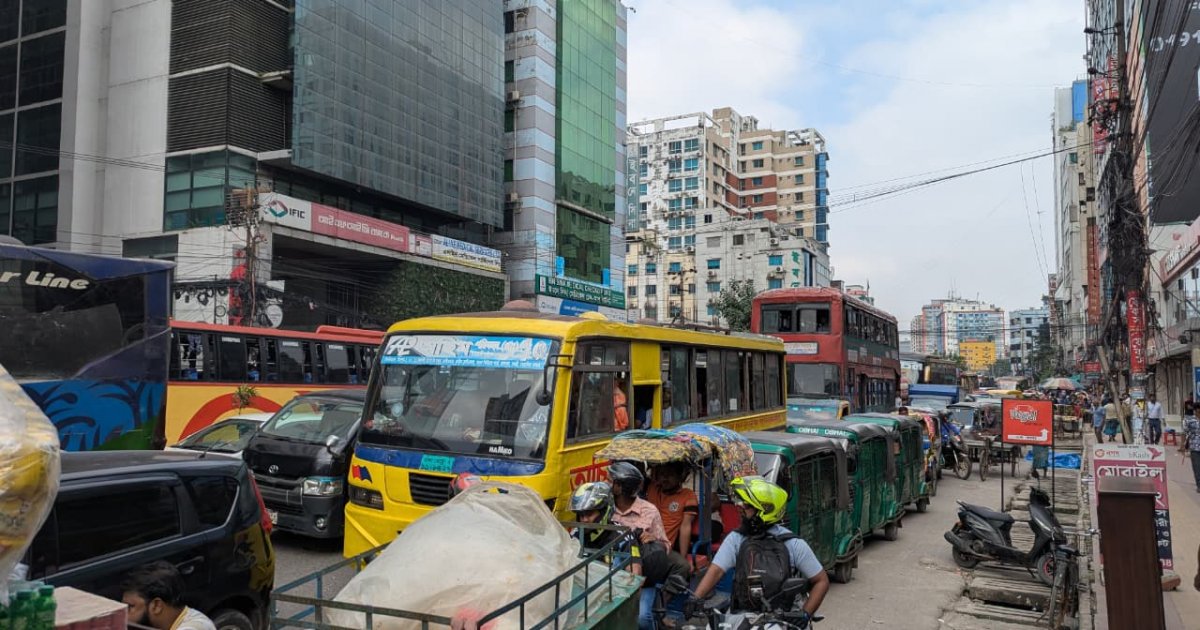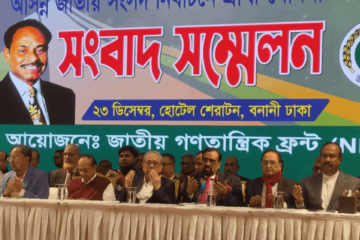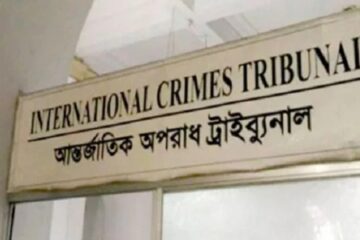At 8:40am on a Sunday, the air at Dhaka’s Gabtoli Bus Terminal feels heavy — a cocktail of exhaust, dust, and impatience.
Dozens of buses sit idling in smoky alignment, their horns blaring like an argument with no end.
Engines growl. Conductors shout.
Passengers, sweating under the morning sun, clutch their bags and elbow their way toward the nearest door.
This reporter joined them that morning, embarking on what should have been a straightforward journey — 33 kilometres from Gabtoli to Demra Staff Quarters.
Google Maps promised it would take one hour and 27 minutes. It took nearly four.
A bus that never quite leaves
By 8:50am, the reporter managed to hop onto an Achim Paribahan bus as it shuddered forward.
Inside, the air was thick with heat and impatience.
The driver, seemingly in no rush, kept the bus idling for another ten minutes in the middle of Gabtoli’s gridlock, hoping to fill every seat before leaving.
The vehicle itself looked like an artifact of Dhaka’s transport history: dented body, cracked windows, and a fresh coat of paint attempting to disguise its decay.
The seats were so cramped that passengers sat folded into themselves, knees pressing into the metal in front.
Passengers shouted at the conductor to move. “Are we going or not?” one barked.
The driver replied with a slow shrug and a horn blast.
Finally, after much yelling, the bus lurched forward, leaving behind a cloud of diesel smoke — but not the chaos.
A crawl through Mirpur’s morning
From Gabtoli to Mirpur-11, just 6.5 kilometres, took 52 minutes.
The bus moved at a crawling speed of 7.5 km/h, slower than a bicycle.
Though the law limits large buses to 52 seats, at least 70 passengers were aboard.
Fifteen stood in the aisle, another ten hung from the open doorway, their bodies swaying precariously with every turn.
Dhaka’s Road Transport Act prescribes minimum space per passenger — 16 square inches for seats, 26 inches between rows — but few buses even nod to such requirements.
“We’re packed like chickens,” said one passenger, a shopkeeper from Mirpur. “And yet, we keep paying more.”
When the bus halted again at Mirpur-10, the conductor jumped down to scream at the traffic police. “If you fine me today,” he yelled, “my family won’t eat tonight.”
The helplessness felt mutual — police, driver, and passengers all prisoners of the same dysfunction.
Sixty-eight stops, eight official stations
Officially, the Gabtoli–Demra route has eight stops. That morning, the bus stopped 68 times.
Every hand raised from the roadside was enough reason for the driver to slam the brakes.
A contractor named Mohammad Ibrahim Khalil, riding along, explained why.
“Fuel alone costs Tk4,500 a day,” he said. “We pay the owner Tk2,700. On good days we make Tk3,000 profit. When the jam’s bad, nothing. That’s why we take extra passengers.”
Beside him sat Md Hossain, a businessman who commutes daily from Mirpur-11.
“I’ve spent half my life in this traffic,” he said with a weary smile. “Dhaka has taught me patience, not progress.”
The bus reached Kuril Flyover at 10:10am, one hour and twenty minutes into the trip.
By then, most passengers were silent, the noise of frustration had turned into the stillness of resignation.
A city moving slower than memory
According to the Dhaka Transport Coordination Authority, 64% of all trips in the capital are by bus.
The average speed: 9.7km/h. During rush hours, it drops to 5–7km/h — roughly the pace of a pedestrian.
Dhaka is a city where time itself gets stuck. Every pause feels endless, every horn a confession of helplessness.
At Jamuna Future Park, the reporter observed hundreds of commuters waiting under the overpass, waving desperately at passing buses.
Most were already full. Some passengers climbed in through windows, others clung to door handles. The air filled with curses and exhaust fumes.
Inside, a small argument erupted when a student demanded half fare. The conductor refused.
“You all want discount,” he said, voice rising. “But do you know how much diesel costs?”
The student muttered back, “Do you know how much patience it costs to live here?”
Theft, harassment, and exhaustion
Crowded buses aren’t just a transport problem; they are theatres of daily humiliation.
In the crush of bodies, women endure harassment, and pickpockets roam freely.
Md Kamruzzaman, an office worker, said he once lost his phone in such a scuffle. “They work in teams. One distracts you, another cuts your bag,” he said. “Every morning is a gamble.”
Later on the route, this reporter witnessed a woman shouting at a man beside her: “Shameless! You touch me again and I’ll call the police!”
The man fled at the next stop, his face pale with fear. No one intervened — passengers turned away, pretending not to hear.
Such silence has become part of Dhaka’s urban etiquette: keep your head down, survive your commute.
Drivers under pressure
At the wheel, driver Kamrul Islam had his own grievances.
“Traffic’s worse every year,” he said. “Too many private cars, too few lanes. And we have to break rules — if we don’t overload, we can’t pay the owner.”
Bus companies operate on the “joma” system — drivers pay a fixed daily rent to owners.
Whatever they earn beyond that is theirs. It’s a model that rewards recklessness. Every extra passenger, every illegal stop, is a small rebellion against starvation.
“People blame us,” Kamrul said, glancing at the jammed road ahead. “But if the system’s broken, how can we drive straight?”
Accidents waiting to happen
At Rampura Bridge, the journey stalled completely.
“Accident ahead,” shouted the conductor, ordering everyone to disembark. The road was blocked by a truck that had flipped hours earlier, still untouched by rescue teams.
Commuters trudged along the footpath, dodging garbage piles and puddles. A bamboo bridge, shaky and narrow, carried hundreds across the road divider. The smell of rot and fumes mingled in the air.
By 12:02pm, two and a half hours in, the reporter boarded another Achim Paribahan bus.
“We’ve been waiting since morning,” said Faridul Islam, a businessman beside him. “My client’s in Demra. I could’ve gone to Noakhali and back by now.”
The economics of chaos
The dysfunction ripples far beyond traffic. A study by the World Bank estimates Dhaka loses over 5 million working hours every day to congestion, costing nearly $12 billion annually.
Urban planners point to uncoordinated agencies, weak enforcement, and political neglect.
“Every flyover, every Metro line, is a patch on a wound that keeps reopening,” said transport analyst Shamsul Hoque. “We need a system, not more roads.”
On the bus, exhaustion was visible.
A man dozed standing, swaying gently with each brake. A woman clutched her child as the vehicle lurched forward.
The conductor shouted destinations like a mantra: “Malibagh! Badda! Rampura!”
The faces around reflected the city’s silent bargain — accept chaos, or be crushed by it.
A city of endurance
At 12:34pm, after 3 hours and 44 minutes, the reporter finally reached Demra Staff Quarters. The average speed: just 8.8 km/h.
Getting off the bus felt like escaping confinement. The legs ached, the lungs burned with dust, and the mind carried the dull fatigue of lost hours.
Yet, for millions, this wasn’t an ordeal — it was routine.
Every morning, Dhaka wakes to the same rhythm of rage and resignation. Workers leave home hours early. Students memorize the shape of gridlock. Drivers curse their luck. Everyone adapts.
“This city doesn’t move,” said Faridul, stepping off behind the reporter. “It endures.”
The anatomy of a trapped city
Dhaka’s transport paralysis is a mirror of its governance: fragmented, reactive, and transactional.
More than 40 agencies share responsibility for traffic management, each with overlapping authority and little coordination.
Despite major investments — the Metro Rail, Bus Rapid Transit corridors, and dozens of flyovers — the core system remains untouched.
Private buses, unregulated and profit-driven, dominate 80% of the market. The result is predictable: chaos disguised as mobility.
In a 2019 report, the Centre for Policy Dialogue warned that Dhaka’s average traffic speed could drop below 5km/h by 2035, slower than a human walk.
That future is already here.
A metaphor in motionlessness
By the end of the journey, this reporter’s ride had become a parable. A city full of motion, yet unable to move.
Dhaka’s roads embody the nation’s contradictions: ambition without coordination, resilience without relief, speed without direction.
Inside the Achim Paribahan bus that morning were 70 stories of survival — workers, students, vendors, mothers — all suspended in the same slow drift toward somewhere else.
Their exhaustion was collective, their endurance remarkable, their patience undeserved.
As the bus doors finally opened at Demra, the words of a passenger lingered: “Time has no value here.”
“In Dhaka, we don’t travel — we survive.”



